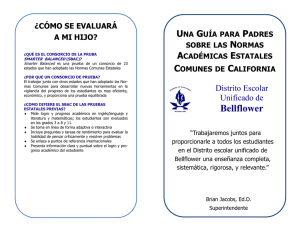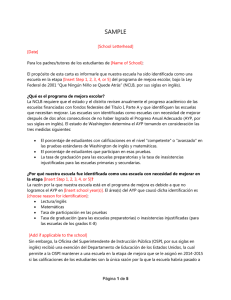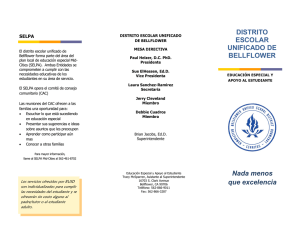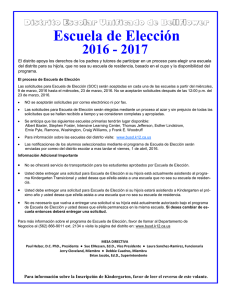Program Improvement District Letter
Anuncio
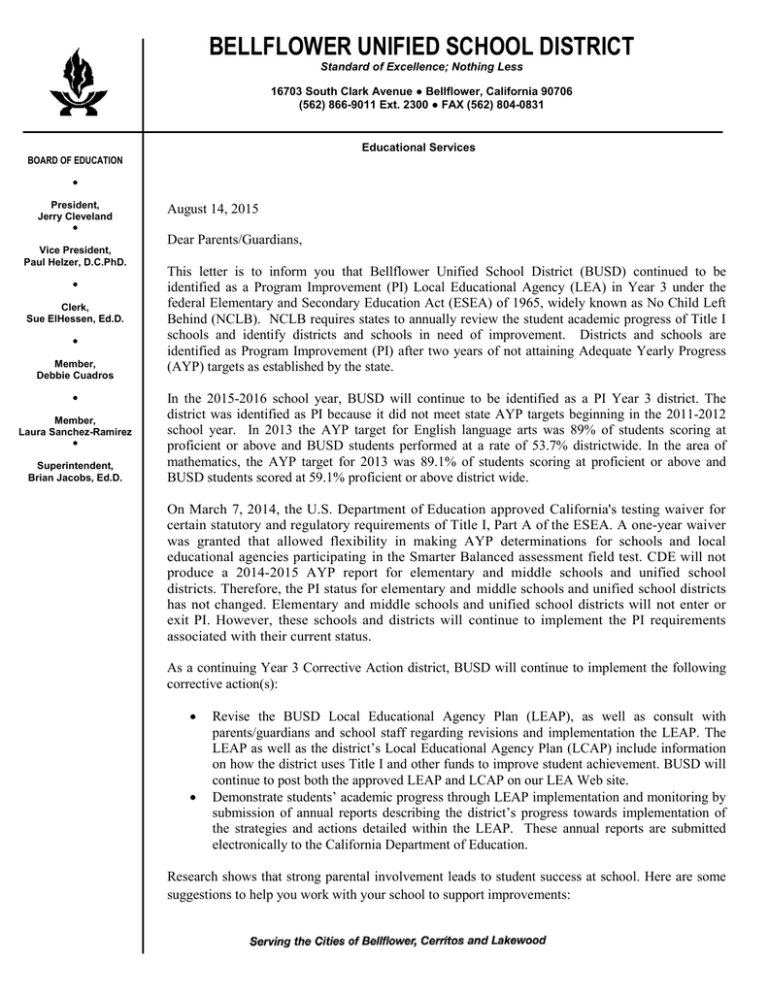
BELLFLOWER UNIFIED SCHOOL DISTRICT Standard of Excellence; Nothing Less 16703 South Clark Avenue ● Bellflower, California 90706 (562) 866-9011 Ext. 2300 ● FAX (562) 804-0831 Educational Services BOARD OF EDUCATION President, Jerry Cleveland Vice President, Paul Helzer, D.C.PhD. Clerk, Sue ElHessen, Ed.D. Member, Debbie Cuadros Member, Laura Sanchez-Ramirez Superintendent, Brian Jacobs, Ed.D. August 14, 2015 Dear Parents/Guardians, This letter is to inform you that Bellflower Unified School District (BUSD) continued to be identified as a Program Improvement (PI) Local Educational Agency (LEA) in Year 3 under the federal Elementary and Secondary Education Act (ESEA) of 1965, widely known as No Child Left Behind (NCLB). NCLB requires states to annually review the student academic progress of Title I schools and identify districts and schools in need of improvement. Districts and schools are identified as Program Improvement (PI) after two years of not attaining Adequate Yearly Progress (AYP) targets as established by the state. In the 2015-2016 school year, BUSD will continue to be identified as a PI Year 3 district. The district was identified as PI because it did not meet state AYP targets beginning in the 2011-2012 school year. In 2013 the AYP target for English language arts was 89% of students scoring at proficient or above and BUSD students performed at a rate of 53.7% districtwide. In the area of mathematics, the AYP target for 2013 was 89.1% of students scoring at proficient or above and BUSD students scored at 59.1% proficient or above district wide. On March 7, 2014, the U.S. Department of Education approved California's testing waiver for certain statutory and regulatory requirements of Title I, Part A of the ESEA. A one-year waiver was granted that allowed flexibility in making AYP determinations for schools and local educational agencies participating in the Smarter Balanced assessment field test. CDE will not produce a 2014-2015 AYP report for elementary and middle schools and unified school districts. Therefore, the PI status for elementary and middle schools and unified school districts has not changed. Elementary and middle schools and unified school districts will not enter or exit PI. However, these schools and districts will continue to implement the PI requirements associated with their current status. As a continuing Year 3 Corrective Action district, BUSD will continue to implement the following corrective action(s): • • Revise the BUSD Local Educational Agency Plan (LEAP), as well as consult with parents/guardians and school staff regarding revisions and implementation the LEAP. The LEAP as well as the district’s Local Educational Agency Plan (LCAP) include information on how the district uses Title I and other funds to improve student achievement. BUSD will continue to post both the approved LEAP and LCAP on our LEA Web site. Demonstrate students’ academic progress through LEAP implementation and monitoring by submission of annual reports describing the district’s progress towards implementation of the strategies and actions detailed within the LEAP. These annual reports are submitted electronically to the California Department of Education. Research shows that strong parental involvement leads to student success at school. Here are some suggestions to help you work with your school to support improvements: • Learn more Enabout NCLB requirements and become aware of strategies to improve student academic achievement. Additional information and resources are available at the following Web sites: The CDE Title I, Part A Web page at http://www.cde.ca.gov/sp/sw/t1/titleparta.asp The CDE Program Improvement Status Determinations Web Page at http://www.cde.ca.gov/ta/ac/ay/tidetermine.asp The ED Web site at http://www.ed.gov and http://www2.ed.gov/parents/landing.jhtml • • • Request and receive information regarding the professional qualifications of your child’s teacher(s). Talk with BUSD staff about the LEAP and the revisions that must be made to help students meet the state standards in ELA and mathematics. Visit your child’s school. You may also participate in voluntary activities to assist your school or the district. If you are a parent/guardian of a student who attends a Title I PI school, you will receive a letter sharing parental/guardian options available to you as it relates to school choice and Supplemental Educational Services. I encourage you to contact your child’s school or my office for further information about any of these requirements and to find out how you can become involved in our efforts to improve student achievement in BUSD. Sincerely, Stacey Everson-Larson Assistant Superintendent of Educational Services (562) 866-9011 Ext. 2300 BELLFLOWER UNIFIED SCHOOL DISTRICT Standard of Excellence; Nothing Less 16703 South Clark Avenue ● Bellflower, California 90706 (562) 866-9011 Ext. 2300 ● FAX (562) 804-0831 Educational Services BOARD OF EDUCATION 14 de agosto 2015 President, Jerry Cleveland Vice President, Paul Helzer, D.C.PhD. Clerk, Sue ElHessen, Ed.D. Member, Debbie Cuadros Estimados Padres/Tutores, Esta carta es para informarle que el Distrito Escolar Unificado de Bellflower (BUSD) continuó siendo identificado como un Programa de Mejoramiento (PI) Agencia Educativa Local (LEA) en el año 3 de la Ley de Educación Primaria y Secundaria Federal (ESEA) de 1965, ampliamente conocida como No Child Left Behind (NCLB). NCLB requiere que los estados revisen anualmente el progreso académico de los estudiantes de las escuelas de Título I y identificar los distritos y las escuelas en necesidad de mejorar. Los distritos y escuelas son identificadas como el Programa de Mejoramiento (PI) después de dos años de no alcanzar los objetivos de Progreso Anual Adecuado (AYP) según lo establecido por el Estado. Member, Laura Sanchez-Ramirez Superintendent, Brian Jacobs, Ed.D. En el año escolar 2015-2016, BUSD continuará siendo identificado como un distrito PI Año 3. El distrito fue identificado como PI, ya que no cumplío con las metas de progreso anual adecuado estatales a partir del año escolar 2011-2012. En 2013 el objetivo AYP por lenguaje y literature en inglés fue del 89% de los estudiantes alcanzaran el nivel proficiente o superior y estudiantes de BUSD anotó 53.7% en todo el distrito. En el área de las matemáticas, el objetivo AYP para 2013 era 89.1% de los estudiantes alcanzaron el nivel proficiente o superior y estudiantes de BUSD anotó en el 59.1% de competente o más en todo el distrito. El 7 de marzo, 2014, el Departamento de Educación de los E.E.U. U. aprobó la exención de California para ciertos requisitos reglamentarios y legislativos de Titulo 1, Parte A del ESEA. Una exención de un afio fue otorgada la cual permite flexibilidad al tomar determinaciones de AYP para las escuelas y las agencias educativas locales que participan en las pruebas de campo de Smarter Balanced. El CDE no producira un informe de AYP en el afto 2014 para las escuelas primarias y secundarias y distritos escolares unificados. Por lo tanto, el estado de PI para las escuelas primarias y secundarias y distritos escolares unificados no ha cambiado. Las escuelas primarias y secundarias y los distritos escolares unificados no entraran ni saldran de una fase del programa de mejoramiento (Pl). Sin embargo, estas escuelas y distritos continuaran implementando los requisitos asociados con el estado actual. Como distrito Año 3 Acción correctiva continua, BUSD continuará implementando las medidas correctivas siguiente (s): • Revisar el Plan de BUSD Educativa Local Agencia (LEAP), así como consultar con los padres / tutores y personal de la escuela en relación con las revisiones y aplicación del LEAP. El LEAP, así como Plan de la Agencia Educativa Local del distrito (LCAP) incluyen información sobre cómo el distrito usa Título I y otros fondos para mejorar el rendimiento estudiantil. BUSD continuará publicar tanto el LEAP y LCAP aprobado en nuestro sitio Web de la LEA. • Demostrar el progreso académico de los estudiantes a través de la implementación y el monitoreo LEAP mediante la presentación de informes anuales que describen el progreso del distrito en la aplicación de las estrategias y acciones que se detallan en el LEAP. Estos informes anuales son enviadas electrónicamente al Departamento de Educación de California. La investigación muestra que una fuerte participación de los padres lleva al éxito de los estudiantes en la escuela. Hay aquí algunas sugerencias para ayudarle a trabajar con su escuela para apoyar las mejor: • Obtenga más información sobre los requisitos NCLB y tomar conciencia de las estrategias para mejorar el rendimiento académico del estudiante. Información adicional y recursos están disponibles en los siguientes sitios Web: • • • El CDE Título I, Parte A la página Web en http://www.cde.ca.gov/sp/sw/t1/titleparta.asp El Estado CDE Programa de Mejoramiento Página Determinaciones Web en http://www.cde.ca.gov/ta/ac/ay/tidetermine.asp El sitio ED Web en http://www.ed.gov y http://www2.ed.gov/parents/landing.jhtml Solicitar y recibir información sobre las calificaciones profesionales del maestro(s) de su hijo. Hable con el personal de BUSD acerca de la LEAP y las revisiones que se deben hacer para ayudar a los estudiantes a cumplir las normas del estado en ELA y matemáticas. Visite la escuela de su hijo. Usted también puede participar en actividades de voluntariado para ayudar a su escuela o el distrito. Si usted es un padre/tutor de un estudiante que asiste a una escuela Título I PI, usted recibirá una carta compartiendo las opciones de los padres/tutores disponibles para usted en lo que respecta a la elección de escuela y servicios educativos suplementarios. Se recomienda a los padres a ponerse en contacto con la escuela de su hijo para obtener más información acerca de cualquiera de estos requisitos y para averiguar cómo puede involucrarse en nuestros esfuerzos para mejorar el rendimiento estudiantil en BUSD. Atentamente, Sincerely, Stacey Larson-Everson Asistente del Superintendente de Servicios Educativos (562) 866-9011 Ext. 2300
